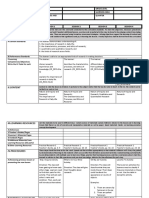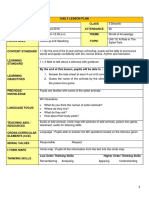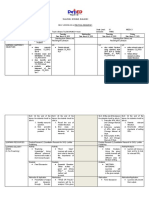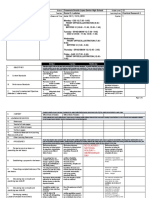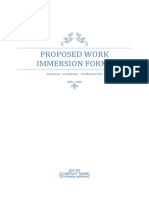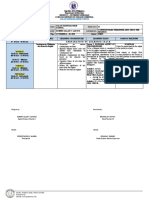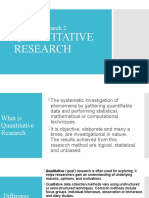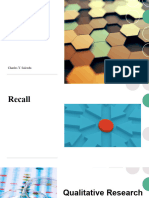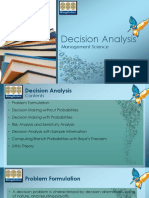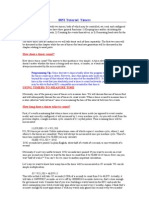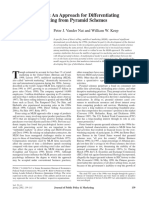0 ratings0% found this document useful (0 votes)
67 viewsLesson 1 Characteristics Strengths Weaknesses Kinds of Quantitaitve Reesearch 1 PDF
Lesson 1 Characteristics Strengths Weaknesses Kinds of Quantitaitve Reesearch 1 PDF
Uploaded by
Kiri SorianoThis document discusses quantitative research methods. It defines quantitative research as using measurable data to quantify problems, attitudes, and behaviors. It then describes key aspects of quantitative research, including using structured instruments to gather large, representative data sets; having clearly defined research questions seeking objective answers; and using tools like questionnaires to collect numerical data. The document also covers strengths like enabling broader studies and objectivity, and limitations such as missing contextual details. It discusses experimental, quasi-experimental, and descriptive quantitative research designs.
Copyright:
© All Rights Reserved
Available Formats
Download as PDF, TXT or read online from Scribd
Lesson 1 Characteristics Strengths Weaknesses Kinds of Quantitaitve Reesearch 1 PDF
Lesson 1 Characteristics Strengths Weaknesses Kinds of Quantitaitve Reesearch 1 PDF
Uploaded by
Kiri Soriano0 ratings0% found this document useful (0 votes)
67 views46 pagesThis document discusses quantitative research methods. It defines quantitative research as using measurable data to quantify problems, attitudes, and behaviors. It then describes key aspects of quantitative research, including using structured instruments to gather large, representative data sets; having clearly defined research questions seeking objective answers; and using tools like questionnaires to collect numerical data. The document also covers strengths like enabling broader studies and objectivity, and limitations such as missing contextual details. It discusses experimental, quasi-experimental, and descriptive quantitative research designs.
Original Title
lesson-1-Characteristics-Strengths-Weaknesses-Kinds-of-Quantitaitve-Reesearch-1 (1).pdf
Copyright
© © All Rights Reserved
Available Formats
PDF, TXT or read online from Scribd
Share this document
Did you find this document useful?
Is this content inappropriate?
This document discusses quantitative research methods. It defines quantitative research as using measurable data to quantify problems, attitudes, and behaviors. It then describes key aspects of quantitative research, including using structured instruments to gather large, representative data sets; having clearly defined research questions seeking objective answers; and using tools like questionnaires to collect numerical data. The document also covers strengths like enabling broader studies and objectivity, and limitations such as missing contextual details. It discusses experimental, quasi-experimental, and descriptive quantitative research designs.
Copyright:
© All Rights Reserved
Available Formats
Download as PDF, TXT or read online from Scribd
Download as pdf or txt
0 ratings0% found this document useful (0 votes)
67 views46 pagesLesson 1 Characteristics Strengths Weaknesses Kinds of Quantitaitve Reesearch 1 PDF
Lesson 1 Characteristics Strengths Weaknesses Kinds of Quantitaitve Reesearch 1 PDF
Uploaded by
Kiri SorianoThis document discusses quantitative research methods. It defines quantitative research as using measurable data to quantify problems, attitudes, and behaviors. It then describes key aspects of quantitative research, including using structured instruments to gather large, representative data sets; having clearly defined research questions seeking objective answers; and using tools like questionnaires to collect numerical data. The document also covers strengths like enabling broader studies and objectivity, and limitations such as missing contextual details. It discusses experimental, quasi-experimental, and descriptive quantitative research designs.
Copyright:
© All Rights Reserved
Available Formats
Download as PDF, TXT or read online from Scribd
Download as pdf or txt
You are on page 1of 46
RESEARCH II
PREPARED BY: CHRISTIAN PAUL C. GUTIERREZ
What is RESEARCH?
Research is a careful, systematic and
objective investigation conducted to
obtain valid facts, draw conclusions, and
establish principles regarding an
identifiable problem in some field of
knowledge.
-Clarke and Clarke
What is RESEARCH?
"Research is a diligent and systematic
inquiry or investigation into a subject
in order to discover facts or
principles."
- American College Dictionary, 1964
What is RESEARCH?
Research comprises “creative work undertaken
on a systematic basis in order to increase the
stock of knowledge, including knowledge of man,
culture and society, and the use of this stock of
knowledge to devise new applications.”
-OECD, 2002
QUANTITATIVE
RESEARCH
•Itis used to quantify the problem by
way of generating numerical data
that can be transformed into
useable statistics.
•Quantitative Research uses
measurable data to formulate facts
and uncover patterns in research.
•It is used to quantify
attitudes, opinions,
behaviors, and other
defined variables – and
generalize results from a
larger sample population.
CHARACTERISTICS OF QUANTITATIVE RESEARCH
•The data is usually gathered using
structured research instruments.
•The results are based on larger sample
sizes that are representative of the
population.
•The research study can usually be
replicated or repeated, given its high
reliability.
CHARACTERISTICS OF QUANTITATIVE RESEARCH
•Researcher has a clearly defined research
question to which objective answers are
sought.
•All aspects of the study are carefully
designed before data is collected.
•Data are in the form of numbers and
statistics, often arranged in tables, charts,
figures, or other non-textual forms.
CHARACTERISTICS OF QUANTITATIVE RESEARCH
•Project can be used to generalize
concepts more widely, predict future
results, or investigate causal
relationships.
•Researcher uses tools, such as
questionnaires or computer software,
to collect numerical data.
Characteristics of Quantitative Research
Methods or procedures of data gathering include
items like ages, gender, educational status, among
others, that call for measurable characteristics of the
population.
Standardized instruments guide data collection, thus,
ensuring the accuracy, reliability and validity of data.
Figures,
tables or graphs showcase summarized data
collected in order to show trends, relationships or
differences among variables. In sum, the charts and
tables allow you to see the evidence collected.
A large population yields more reliable data,
but principles of random sampling must be
strictly followed to prevent researcher’s bias.
Quantitative methods can be repeated to verify
findings in another setting, thus, reinforcing
validity of findings.
Quantitative research puts emphasis on proof,
rather than discovery.
STRENGTHS OF QUANTITATIVE RESEARCH
•Allows for a broader study,
involving a greater number of
subjects, and enhancing the
generalization of the results;
•Allows for greater objectivity
and accuracy of results.
STRENGTHS OF QUANTITATIVE RESEARCH
•Applying well established standards
means that the research can be
replicated, and then analyzed and
compared with similar studies;
•You can summarize vast sources of
information and make comparisons
across categories and over time; and,
STRENGTHS OF QUANTITATIVE RESEARCH
•Personal bias can be
avoided by keeping a
'distance' from participating
subjects and using accepted
computational techniques.
LIMITATIONS OF QUANTITATIVE RESEARCH
•Quantitative data is more
efficient and able to test
hypotheses, but may miss
contextual detail;
•Uses a static and rigid approach
and so employs an inflexible
process of discovery;
LIMITATIONS OF QUANTITATIVE RESEARCH
•The development of standard questions
by researchers can lead to "structural
bias" and false representation, where the
data actually reflects the view of the
researcher instead of the participating
subject;
•Results provide less detail on behavior,
attitudes, and motivation;
LIMITATIONS OF QUANTITATIVE RESEARCH
•Researcher may collect a much
narrower and sometimes superficial
dataset;
•Results are limited as they provide
numerical descriptions rather than
detailed narrative and generally provide
less elaborate accounts of human
perception;
LIMITATIONS OF QUANTITATIVE RESEARCH
•The research is often carried out in an
unnatural, artificial environment so that a
level of control can be applied to the
exercise.
•Present answers will not necessarily
reflect how people really feel about a
subject and, in some cases, might just be
the closest match to the preconceived
hypothesis.
Strengths and weaknesses of
Quantitative Research
Quantitative research design is the most reliable and valid
way of concluding results, giving way to a new hypothesis
or to disproving it.
Because of bigger number of the sample of a population,
the results or generalizations are more reliable and valid.
Quantitative experiments filter out external factors, if
properly designed, and so the results gained can be seen,
as real and unbiased. Quantitative experiments are useful
for testing the results gained by a series of qualitative
experiments, leading to a final answer, and narrowing
down of possible directions to follow.
Weaknesses
Quantitative
research can be costly, difficult and time-
consuming-difficult because most researchers are non-
mathematicians.
Quantitative studies require extensive statistical treatment,
requiring stringent standards, more so with confirmation of
results. When ambiguities in some findings surface, retesting
and refinement of the design call for another investment in
time and resources to polish the results.
Quantitative methods also tend to turn out only proved or
unproven results, leaving little room for uncertainty, or grey
areas. For the social sciences, education, anthropology and
psychology, human nature is a lot more complex than a
simple yes or no response.
Quantitative Research Designs
Research design- refers to the overall strategy that you
choose in order to integrate the different components of
the study in a coherent and logical way. Furthermore, a
research design constitutes the blueprint for the
selection, measurement and analysis of data. The
research problem determines the research design you
should use.
Experimental research is commonly used in sciences
such as sociology and psychology, physics, chemistry,
biology and medicine etc. It is a collection of
research designs which use manipulation and
controlled testing to understand causal processes.
Generally, one or more variables are manipulated to
determine their effect on a dependent variable.
The experimental method is a systematic and
scientific approach to research in which the researcher
manipulates one or more variables, and controls and
measures any change in other variables.
TYPES OF QUANTITATIVE RESEARCH
Experimental Designs, often called true
experimentation, use the scientific method to
establish cause-effect relationship among a group
of variables in a research study. Researchers make
an effort to control for all variables except the one
being manipulated (the independent variable). The
effects of the independent variable on the
dependent variable are collected and analyzed for
a relationship.
A Quasi-Experimental Design (often referred to as Causal-
Comparative)-Quasi-experimental design involves selecting
groups, upon which a variable is tested, without any random
pre-selection processes.
Forexample, to perform an educational experiment, a class
might be arbitrarily divided by alphabetical selection or by
seating arrangement. The division is often convenient and,
especially in an educational situation, causes as little
disruption as possible.
After
this selection, the experiment proceeds in a very similar
way to any other experiment, with a variable being
compared between different groups, or over a period of time.
Types of Quasi-Experimental Design
1.Non-equivalent control group
design-refers to the chance failure of
random assignment to equalize the
conditions by converting a true
experiment into this kind of design, for
purposes of analysis.
2. Interrupted Time Series Design- employs
multiple measures before and after the
experimental intervention. It differs from
the single-group pre-experiment that has
only one pretest and one posttest. Users
of this design assume that the time threats
such as history or maturation appear as
regular changes in the measures prior to
the intervention.
A Descriptive Design seeks to
describe the current status of a
variable or phenomenon. The
researcher does not begin with a
hypothesis, but typically develops
one after the data is collected.
Data collection is mostly
observational in nature.
Types of Descriptive Research Designs
1.Survey - a research design used when the
researcher intends to provide a quantitative or
numeric description of trends, attitudes or opinions
of a population by studying a sample of that
population (Creswell, 2003). For example,
universities regularly float surveys to determine
customer satisfaction, that is, the students‘
attitudes toward or opinions regarding student
services like the canteen, clinic, security, the
guidance and counseling services, and the like.
2. Correlational - Correlational Research has
three types:
- Bivariate correlational studies- obtain scores from
two variables for each subject, then use them to
calculate a correlation coefficient. The term
bivariate implies that the two variables are
correlated (variables are selected because they
are believed to be related).
Examples: Children of wealthier (variable #1),
better educated (variable #2) parents earn higher
salaries as adults.
-Prediction studies-use correlation co-efficient to show
how one variable (the predictor variable) predicts
another (the criterion variable).
Examples: Which high school applicants should be
admitted to college?
- Multiple Regression Prediction Studies- suppose the high
school GPA is not the sole predictor of college GPA, what
might be other good predictors? All of these variables
can contribute to the over-all prediction in an equation
that adds together the predictive power of each
identified variable.
3. Ex-Post Facto Research Design- These are non-
experimental designs that are
used to investigate causal relationships. They
examine whether one or more pre-existing
conditions could possibly have caused subsequent
differences in groups of subjects. Researchers
attempt to discover whether differences between
groups have results in an observed difference in the
independent variables.
Examples: What is the effect of home schooling on
the social skills of adolescents?
4.Comparative design - involves comparing and
contrasting two or more samples of study subjects
on one or more variables, often at a single point of
time. Specifically, this design is used to compare
two distinct groups on the basis of selected
attributes such as knowledge level, perceptions,
and attitudes, physical or psychological symptoms.
For example, a comparative study on the
effectiveness of teaching Science to Gr. 12
students using structured and unstructured
approach.
5. Evaluative Research - seeks to assess or
judge in some way providing information
about something other than might be
gleaned in mere observation or
investigation of relationships.
For example, where a test of children in
school is used to assess the effectiveness
of teaching or the deployment of a
curriculum.
Formative evaluation is used to
determine the quality of implementation
of a project, the efficiency and
effectiveness of a program, assessment
of organizational processes like
procedures, policies, guidelines, human
resource development and the like.
6. Methodological - in this approach,
the implementation of a variety of
methodologies forms a critical part of
achieving the goal of developing a
scale-matched approach, where
data from different disciplines can be
integrated.
Experimental research design allows the researcher to
control the situation. In so doing, it allows the researcher
to answer the question, “What causes something to
occur?” This kind of research also allows the researcher
to identify cause and effect relationships between
variables and to distinguish placebo effects from
treatment effects.
Further, this research design supports the ability to limit
alternative explanations and to infer direct causal
relationships in the study; the approach provides the
highest level of evidence for single studies.
Pre-experimental types of research apply to experimental designs with the least
internal validity. One type of pre-experiment, the single group, pre-test-post-test
design,
measures the group two times, before and after the intervention.
Instead of comparing the pretest with the posttest within one group, the posttest of
the treated groups is compared with that of an untreated group. Measuring the
effect as
the difference between groups marks this as between-subjects design. Assuming
both
groups experienced the same time-related influences, the comparison group feature
should protect this design from the rival explanations that threaten the within-subject
design.
You might also like
- Around The World Cookbook by Katya HenryDocument49 pagesAround The World Cookbook by Katya HenryIva-Marija MatulecNo ratings yet
- Inventing The Opera HouseDocument276 pagesInventing The Opera HouseIvánNo ratings yet
- © 2014 Pearson Education, IncDocument33 pages© 2014 Pearson Education, IncKiri SorianoNo ratings yet
- CIDAM FOR Practical Research 1 FinalDocument6 pagesCIDAM FOR Practical Research 1 FinalThelma LanadoNo ratings yet
- Covid - Essential Commodities List - Patiala - 25 MarDocument62 pagesCovid - Essential Commodities List - Patiala - 25 MarGursimrat SinghNo ratings yet
- G.R. No. 17958Document2 pagesG.R. No. 17958Pawix 55100% (1)
- Unit 1 Prac Res 2Document25 pagesUnit 1 Prac Res 2Aaron Justine JucoNo ratings yet
- 1 Characteristics Strengths Weaknesses and Kinds of Quantitative ResearchDocument26 pages1 Characteristics Strengths Weaknesses and Kinds of Quantitative ResearchHarold LimboNo ratings yet
- Nature of Inquiry and Research (First Quarter - Week 2)Document42 pagesNature of Inquiry and Research (First Quarter - Week 2)Ron Adrian AbustanNo ratings yet
- Lesson 2 INQUIRY and ResearchDocument35 pagesLesson 2 INQUIRY and ResearchAdanalee SolinapNo ratings yet
- Practical Research 1 Budget of WorkDocument3 pagesPractical Research 1 Budget of WorkDeborah Gracia SarabiaNo ratings yet
- CS - RS1 DLL June 4 - 8, 2018 Grade 12Document4 pagesCS - RS1 DLL June 4 - 8, 2018 Grade 12ZOSIMO PIZONNo ratings yet
- Chapter Three Research Methodology IntroDocument4 pagesChapter Three Research Methodology IntroANNALLENE MARIELLE FARISCALNo ratings yet
- PR2 210 - Practical Research Q1 M1 - Nature of Inquiry and ResearchDocument28 pagesPR2 210 - Practical Research Q1 M1 - Nature of Inquiry and ResearchMariquina ErwinNo ratings yet
- Week 1 Lesson 1Document3 pagesWeek 1 Lesson 1dayah3101No ratings yet
- Teaching Guide - Practical ResearchDocument8 pagesTeaching Guide - Practical ResearchStud McKenzeeNo ratings yet
- Practical-Research-DLL-Week 3Document3 pagesPractical-Research-DLL-Week 3JIMP ISRAEL CABUHATNo ratings yet
- Action Research For Grade 11Document52 pagesAction Research For Grade 11Quennee Ronquillo EscobilloNo ratings yet
- PR2 DLL Week5Document2 pagesPR2 DLL Week5Neil John De VeraNo ratings yet
- SHS Core Subjects Matrix For The Learning Continuity PlanDocument25 pagesSHS Core Subjects Matrix For The Learning Continuity PlanLouie Cisneros del MundoNo ratings yet
- Module 2 Qualitative ResearchDocument21 pagesModule 2 Qualitative Researchbryan lantinNo ratings yet
- 3statement of The ProblemDocument2 pages3statement of The ProblemJean CatandijanNo ratings yet
- DLL NEW WEEKLY - Prac Res 1Document27 pagesDLL NEW WEEKLY - Prac Res 1Zenmar gendiveNo ratings yet
- DLL-PRACTICAL-RESEARCH (Done)Document4 pagesDLL-PRACTICAL-RESEARCH (Done)Sherilyn Dotimas Bugayong100% (2)
- Practical Research 1 Lesson PlanDocument2 pagesPractical Research 1 Lesson PlanAishah AtomarNo ratings yet
- Differentiates Kinds of Variables and Their UsesDocument4 pagesDifferentiates Kinds of Variables and Their UsesRomelSorianoLadislaoNo ratings yet
- Lesson Plan in Practical Research 2: (Quantitative Research For SHS) - Manila: Lorimar Publishing, IncDocument2 pagesLesson Plan in Practical Research 2: (Quantitative Research For SHS) - Manila: Lorimar Publishing, IncJan Quinicio100% (1)
- PR2-deepening - PPT Final 2Document107 pagesPR2-deepening - PPT Final 2Cherry EscaladaNo ratings yet
- Caliling National High SchoolDocument31 pagesCaliling National High Schoollorena vicenteNo ratings yet
- Qualitative StudyDocument63 pagesQualitative StudyJohn Bryan100% (2)
- Department of Education: Republic of The PhilippinesDocument3 pagesDepartment of Education: Republic of The PhilippinesAshley CarlosNo ratings yet
- Final Demo DLP V4Document18 pagesFinal Demo DLP V4Mary Rose AlegriaNo ratings yet
- Practical Research 2 DLP 28Document4 pagesPractical Research 2 DLP 28Jumps LaroaNo ratings yet
- Quiz in Practical Research 2Document2 pagesQuiz in Practical Research 2Anthony YadaoNo ratings yet
- Hupi National High School: MEMAROPA Region Santa Cruz MarinduqueDocument101 pagesHupi National High School: MEMAROPA Region Santa Cruz MarinduqueJessy BascoNo ratings yet
- Forms ImmersionDocument10 pagesForms ImmersionMARK JOHN SAN DIEGONo ratings yet
- Lesson Guide in PRACTICAL RESEARCH 1 I. Objectives: Nature of Inquiry and ResearchDocument2 pagesLesson Guide in PRACTICAL RESEARCH 1 I. Objectives: Nature of Inquiry and ResearchMark Jason DomingoNo ratings yet
- 1: 1: 1 Quantitative Research. CS-RS12-Ia-c-1: ActivityDocument3 pages1: 1: 1 Quantitative Research. CS-RS12-Ia-c-1: ActivityJown Honenew LptNo ratings yet
- Research Abstract Template by Sir Romel LadislaoDocument2 pagesResearch Abstract Template by Sir Romel LadislaoRomelSorianoLadislaoNo ratings yet
- DLL 2nd Sem - Research 1 - WK 2 - Nov 21-25 - Purpose of Research, Types & ApproachesDocument3 pagesDLL 2nd Sem - Research 1 - WK 2 - Nov 21-25 - Purpose of Research, Types & ApproachesSteffiNo ratings yet
- Demo DLL 2 RESEARCHDocument4 pagesDemo DLL 2 RESEARCHMary DignosNo ratings yet
- Practical Research 1Document82 pagesPractical Research 1Bayoyong Nhs100% (1)
- CPAR ReviewerDocument11 pagesCPAR ReviewerAngelo PeraltaNo ratings yet
- Qualitative ResearchDocument20 pagesQualitative ResearchJv Loo CaguioaNo ratings yet
- Lesson 1&2-Importance or Research Lesson 1Document29 pagesLesson 1&2-Importance or Research Lesson 1Cel AycoNo ratings yet
- DLP PPTP TionDocument1 pageDLP PPTP TionVersoza NelNo ratings yet
- PRACTICAL RESEARCH 2 PowerPointDocument31 pagesPRACTICAL RESEARCH 2 PowerPointYohan Ignacio GoNo ratings yet
- WHLP (Cpar) Week 4Document2 pagesWHLP (Cpar) Week 4Robert Allan GayosoNo ratings yet
- Research in Daily Life 2 SyllabusDocument7 pagesResearch in Daily Life 2 SyllabusAyyah0% (1)
- PSS DLLDocument2 pagesPSS DLLNoemi DenostaNo ratings yet
- DLP Prac. Research IDocument9 pagesDLP Prac. Research IJas MonteroNo ratings yet
- 01-Nature of Inquiry and ResearchDocument16 pages01-Nature of Inquiry and ResearchRay DomingoNo ratings yet
- Creative Writing Weekly Home Learning PlanDocument3 pagesCreative Writing Weekly Home Learning PlanSun Shine OalnacarasNo ratings yet
- Writing Chapter 3Document34 pagesWriting Chapter 3Mel P. ManaloNo ratings yet
- Examination PR 2Document6 pagesExamination PR 2ariane lagaticNo ratings yet
- DLL QuantiQualiDocument4 pagesDLL QuantiQualizchardzyNo ratings yet
- Research Summative Second QuarterDocument3 pagesResearch Summative Second QuarterRAZEL ALCANTARANo ratings yet
- Practical Research 2Document63 pagesPractical Research 2MaryJoyceRamosNo ratings yet
- Lesson 1 Synthesizing RRLDocument11 pagesLesson 1 Synthesizing RRLゔ違でStrawberry milkNo ratings yet
- Practical Research 2 Final ExamDocument9 pagesPractical Research 2 Final ExamAnnalyn CasipongNo ratings yet
- Lesson 1Document2 pagesLesson 1Marky Zhaijan RamosNo ratings yet
- Session 1Document22 pagesSession 1Alpha Parman BagorioNo ratings yet
- Chapter 1-3 BiologyDocument10 pagesChapter 1-3 BiologyBea Trixie BeareNo ratings yet
- Lesson 1-Characteristics, Strengths, Weaknesses.Document36 pagesLesson 1-Characteristics, Strengths, Weaknesses.erica lamsenNo ratings yet
- Inbound 4589109284561518719Document38 pagesInbound 4589109284561518719Wayne AgudaNo ratings yet
- Interpretation of ContractsDocument8 pagesInterpretation of ContractsKiri SorianoNo ratings yet
- Topic 4 Decision AnalysisDocument45 pagesTopic 4 Decision AnalysisKiri SorianoNo ratings yet
- Defective ContractsDocument41 pagesDefective ContractsKiri Soriano100% (1)
- Chapter 13 Corporations and Stockholders' EquityDocument23 pagesChapter 13 Corporations and Stockholders' EquityKiri SorianoNo ratings yet
- EIDR Updated List of Outputs As of June 4 2018 1Document22 pagesEIDR Updated List of Outputs As of June 4 2018 1Kiri SorianoNo ratings yet
- 2010-02-11 010215 LayneDocument1 page2010-02-11 010215 LayneKiri SorianoNo ratings yet
- The One Sample Z TestDocument7 pagesThe One Sample Z TestKiri SorianoNo ratings yet
- RRLLLLLDocument3 pagesRRLLLLLLovely Shayne Dela CruzNo ratings yet
- Quicknotes in Income TaxDocument13 pagesQuicknotes in Income TaxTrelle DiazNo ratings yet
- Big BazaarDocument15 pagesBig BazaarSuhas RNo ratings yet
- Stanish Origen Estado Sud AmericaDocument24 pagesStanish Origen Estado Sud AmericaTony SneijderNo ratings yet
- Engineering Thermodynamics Solution Manual by RK R PDFDocument2 pagesEngineering Thermodynamics Solution Manual by RK R PDFanchalNo ratings yet
- NCERT Solutions For Class 7 Geography Chapter 1 EnvironmentDocument4 pagesNCERT Solutions For Class 7 Geography Chapter 1 Environmentjyothi.panatiNo ratings yet
- BOLD Universal PC Stories and Deeds GeneratorDocument14 pagesBOLD Universal PC Stories and Deeds GeneratorGiles Metcalfe100% (2)
- Sample Research Proposal For BS Commerce StudentsDocument10 pagesSample Research Proposal For BS Commerce Studentshasnain rabbaniNo ratings yet
- 34 Laws of Courtship by D K Olukoya Olukoya, D K Z Lib OrgDocument121 pages34 Laws of Courtship by D K Olukoya Olukoya, D K Z Lib OrgJacinta Samalengi100% (2)
- Chatgpt's Take On EmotionsDocument2 pagesChatgpt's Take On Emotionssrivatsan mNo ratings yet
- The IB DP English Learner PortfolioDocument1 pageThe IB DP English Learner PortfolioVikas TanwarNo ratings yet
- Configuration Guide - Interface Management (V200R002C01 - 01) PDFDocument217 pagesConfiguration Guide - Interface Management (V200R002C01 - 01) PDFSyedShahzaibNo ratings yet
- Case Analysis of Amul FinalDocument24 pagesCase Analysis of Amul FinalSarabjit Singh100% (1)
- Activity Based CDocument12 pagesActivity Based CAman Sukhija100% (2)
- UNITDocument1 pageUNITsaritalodhi636No ratings yet
- OpenText Vendor Invoice Management For SAP Solutions 20.4 - Administration Guide English (VIM200400-AGD-EN-04)Document258 pagesOpenText Vendor Invoice Management For SAP Solutions 20.4 - Administration Guide English (VIM200400-AGD-EN-04)Ignacio FranciaNo ratings yet
- Atin OnDocument2 pagesAtin OnOksana YaremkoNo ratings yet
- Innacomm w7100n User ManualDocument3 pagesInnacomm w7100n User Manualmohd arsyeedNo ratings yet
- GSG WarscrollsDocument34 pagesGSG WarscrollscachallNo ratings yet
- 8051 Tutorial: Timers: How Does A Timer Count?Document8 pages8051 Tutorial: Timers: How Does A Timer Count?Heyang LiuNo ratings yet
- Food VocabularyDocument22 pagesFood VocabularysofinglishNo ratings yet
- DISC SYSTEM TO GRADE 7 STE STUDENTS FinalDocument24 pagesDISC SYSTEM TO GRADE 7 STE STUDENTS FinalRonel DayoNo ratings yet
- Past Year Far460 - Dec 2014Document7 pagesPast Year Far460 - Dec 2014Alief Zazman100% (1)
- Vander Nat and Keep - MLM 2002Document13 pagesVander Nat and Keep - MLM 2002Bill KeepNo ratings yet
- Id and Supplier Certificate PDFDocument7 pagesId and Supplier Certificate PDFMoses BurlaNo ratings yet
- User's Manual: GT20B-SBDocument127 pagesUser's Manual: GT20B-SBRazvan KalavrezosNo ratings yet











